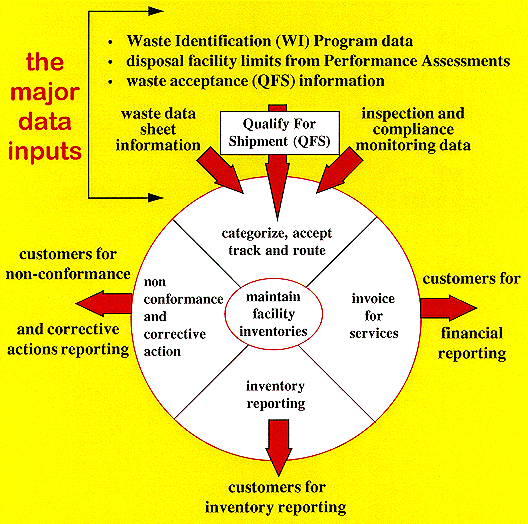
Fig. 1. Waste management functions
that are integrated within WIP-III
Table I WIP-III Compared with a "Typical Waste Inventory
Database"
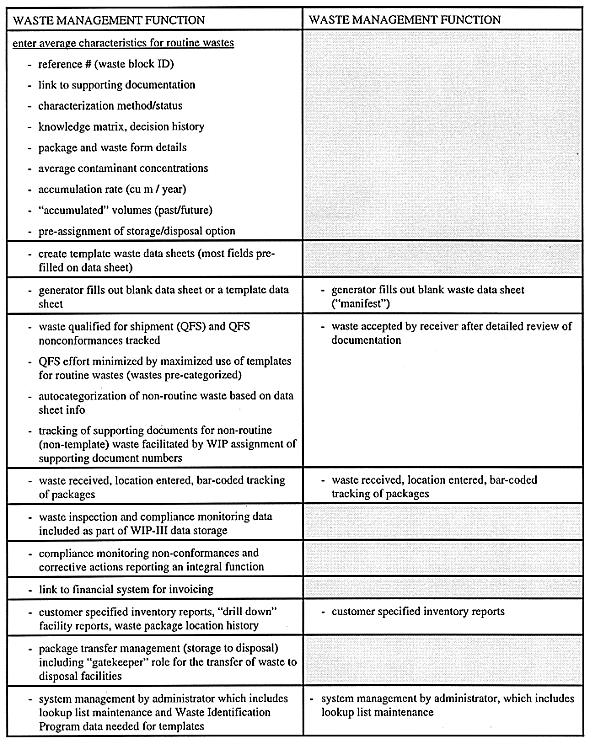
M.A. ter Huurne, G.W. Csullog, S.M. Dunford, V.R. Hulley,
J.D.M. Martin, M.T. Miller
Atomic Energy of Canada Limited
Chalk River
Laboratories
Chalk River, Ontario, Canada, K0J 1J0
(613) 584-3311
ABSTRACT
The Waste Inventory Programs (WIP) application was developed by Atomic Energy of Canada Limited (AECL) in the mid 1980's as a typical, inventory database to record and report on wastes in AECL's storage facilities. The latest version, WIP-III, was developed to integrate waste inventory management with a variety of day-to-day waste management operations, by incorporating functions such as:
- invoicing for waste management services provided to customers,
- tracking of preshipment (waste data sheet) non-conformances,
- integration of inspection and compliance monitoring data,
- integration of hazardous waste classification,
- recording/reporting inspection and compliance monitoring non-conformances/corrective actions,
- recording and reporting of authorized changes to data,
- automatic categorization for disposal by comparing quantities of contaminants reported with contaminant limits established by performance assessments, and
- linking of waste characteristics reported to supporting documentation.
Routine waste acceptance is supported by the Waste Identification (WI) Program, which requires generators to 1) develop waste management plans, 2) provide facility maps and process/waste flow sheets and 3) assess the characteristics of their processes and each routine "waste block" generated. The information about process and waste block characteristics is entered into WIP-III, which assigns a unique identifier to each process and waste block.
WIP-III prints hard copy, template data sheets that are pre-populated with the information entered from the WI Program. In addition, by entering a waste block number, the WIP-III electronic data sheet is also pre-populated with the same information. Template data sheets 1) simplify generator training, 2) minimize generator effort for "paperwork", 3) make data entry faster and less prone to errors and 4) directly link the information on waste data sheets (used for day-to-day shipments) to the information assembled in the WI Program.
WIP-III is a client/server application. The user interface is a Windows front-end developed using PowerSoft's PowerBuilder development tools. A VAX server runs the ORACLE7 relational database where the data reside. Data access points are PCs (at least 486) running Microsoft Windows v.3.11 or Windows 95.
The application was developed in phases, with pre-defined documentation and deliverables reviewed and approved at each phase. Extensive manual and automated testing of each phase rounded out the QA development process.
Design issues for each phase focused on integrating the application's functions with work processes. Data integrity is also a major feature of the application - validation rules and limits are verified for each field and many enterable fields only allow selection from an authorized 'lookup list'.
INTRODUCTION
During the mid 1980's, Waste Management and Decommissioning Operations (WMDO) at Atomic Energy of Canada's (AECL) Chalk River Laboratories (CRL) implemented a database to record waste receipts and the locations of wastes placed into interim storage facilities. Two successive versions of the Waste Inventory Programs (WIP) were implemented on the CRL site's CYBER mainframe. For WIP-I, data entry was performed using dumb terminals to directly enter information into the CYBER database. For WIP-II, data entry was performed on stand-alone personal computers where data were validated and then transferred to the CYBER database.
After several years of WIP-II usage, an in depth study was undertaken to review the quality of the data being managed and to be managed. Requirements for waste acceptance were changing and generators were being required to provide ever increasing detail about the characteristics of their wastes. It was clear that WIP-II would have to be upgraded to manage the large increase in waste management data expected.
The WIP-II study also revealed opportunities to develop and implement WIP-III in a way that would integrate data management requirements with day-to-day waste management operations. WIP-III was envisioned as far more than a database that would be "added on" to operations to record waste receipts and storage locations. WIP-III was to be developed to:
Figure 1 shows the major waste management functions that were identified for integration with WIP-III. Table I compares WIP-III with a "typical waste inventory database".

Fig. 1. Waste management functions
that are integrated within WIP-III
Table I WIP-III Compared with a "Typical Waste Inventory
Database"

This paper describes the WIP-III data management system that was developed to meet the objectives described above.
WIP-III DESIGN REQUIREMENTS AND IMPLEMENTATION
Table II lists the principal design requirements for the WIP-III application and the implementation for these requirements. WIP-III was engineered to input much more data in less time with fewer errors than had been possible with WIP-II while at the same time integrating the functions of separate databases and minimizing associated administrative and training costs.
Table II WIP-III Design Requirement
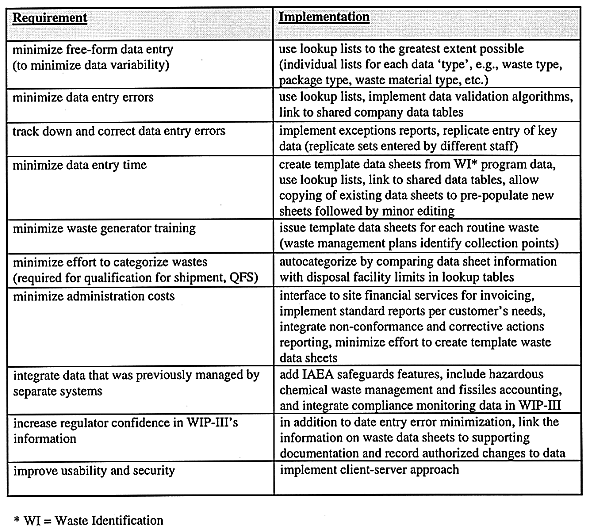
Reducing the Time, Effort and Costs Associated with Data Management
A key implementation feature of WIP-III is the extensive use of shared AECL company tables and WIP-III specific lookup lists. Shared tables, such as customer and work order tables, minimize the work and errors associated with customer invoicing. WIP-III custom lists, maintained by the WIP Administrator (WIP-ADM), restrict the use of free-form data entry (replace garbage in-garbage out, GIGO, with knowledge in-knowledge out, KIKO) and minimize data entry time and errors. Figure 2 identifies some of the lookup lists currently implemented in WIP-III.
Fig. 2. Composite WIP-III screen capture showing some lookup lists.
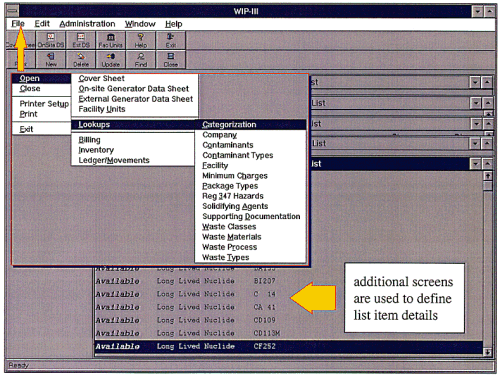
The use of lookup lists is similar to the use of the United States Nuclear Regulatory Commission's Container Description, Waste Descriptor and Sorption, Solidification, and Stabilization Media Codes on the "Uniform Low-Level Radioactive Waste Manifest: Container and Waste Description" form (NRC form 541 [3-95] ). With WIP-III, the use of lookup lists is more extensive and appears to be more flexible for meeting waste generator requirements.
Some lookup lists have "in-use flags" for items in the list. For example, the WIP-ADM can set the in-use flag to NO for specific storage facilities once the physical facilities are closed. Once the flag is set to NO for a facility, the data entry person is unable to select that facility as a storage location. This process minimizes the length of the facilities list (less information to search) and it prevents the accidental selection of a closed facility as the storage location.
In addition to lookup lists, a variety of validation algorithms are used to minimize data entry errors. For example, checks on the quantities of radionuclides entered onto a data sheet are used to trigger a request for a gain/loss or transfer number to ensure proper accounting and traceability of fissile radionuclides.
Locating and Correcting Errors
While data entry errors are minimized, they are not completely eliminated. As such, two approaches have been taken to identify and correct errors.
The first is exceptions reporting. Algorithms have been implemented to identify possible mismatches in parameter values. For example, some types of wastes are not permitted in certain storage facilities and exceptions reports are run to identify cases where the wrong storage location for waste packages may have been selected from a lookup list.
The second approach uses separate data entry screens to input key data a second time (similar to dual entry accounting). Using WIP-III's use of roles, the same person is not allowed to key in the replicate data (to minimize the chance of the same error being made twice).
Streamlining Waste Acceptance (for both the waste generator and the waste receiver)
The feature of WIP-III that most sets it apart from typical waste inventory database applications is the implementation of Waste Identification (WI) Program lookup tables.
The WI Program, see Table III, was set up to:
Table III The Six Steps of the Waste Identification Program to
Identify and Categorize Routine Wastes
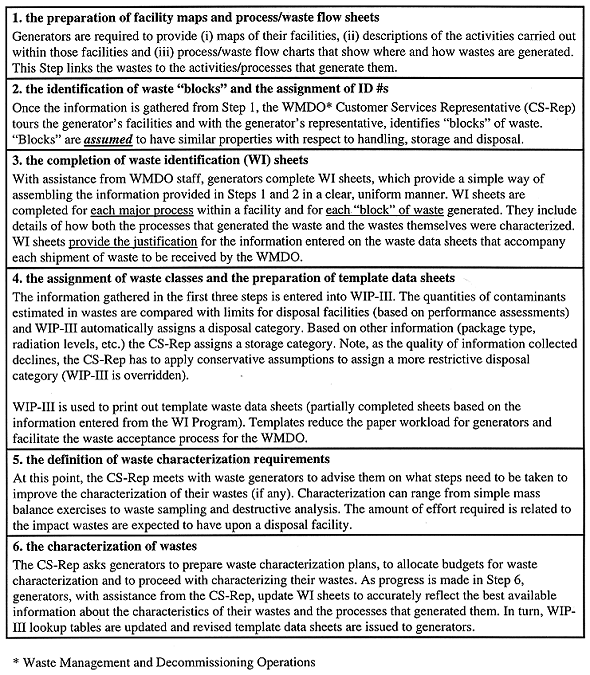
The natural consequence of the WI Program is the generation of large amounts of information and data associated with identifying and characterizing processes and wastes and with the mapping of waste to collection points within generators' facilities. Using a typical waste inventory database approach, WMDO would have been faced with either the routine entry of large amounts of data that are recorded on waste data sheets ("manifests") or simply cross-referencing documentation that described waste characteristics (with the latter approach, running inventories of radionuclides and toxic hazardous inventories could not be effectively maintained for storage or disposal facilities).
Therefore, WIP-III was engineered to "warehouse" information collected from the WI Program and to pass this information from lookup lists to pre-populate waste data sheets for generators to use. Figures 3A and 3B provide an overview of how WIP-III is used to manage WI Program data.
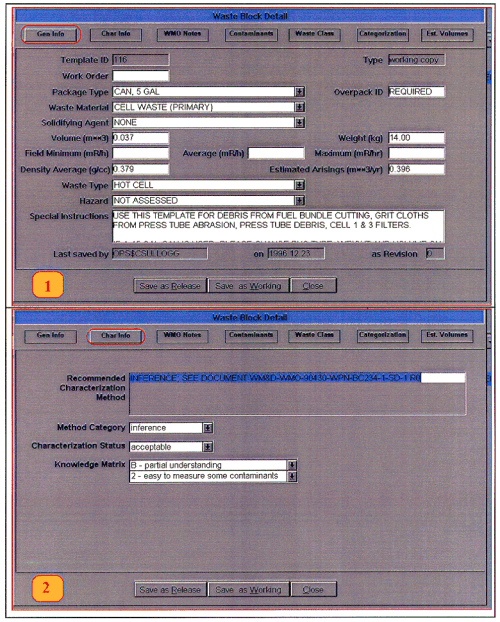
Fig. 3A. Composite WIP-III screen
capture showing entry screens for WI program data.
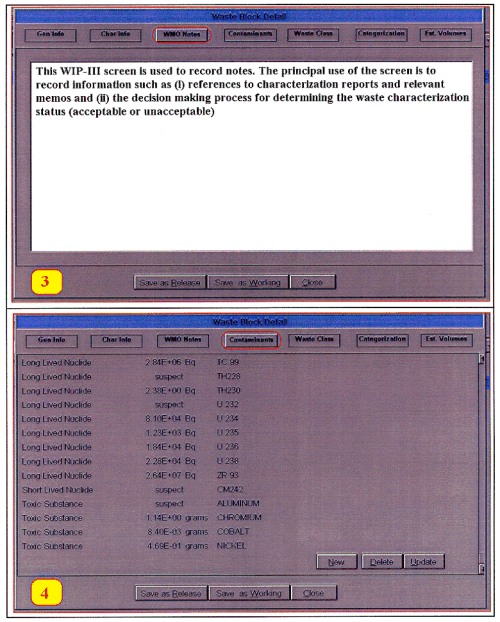
Fig. 3B. Composite WIP-III screen
capture showing entry screens for WI program data.
Screen captures 1 in Fig. 3A and 4 in Fig. 3B (accessed by clicking the Gen Info and Contaminants buttons, respectively), show the WI Program information that is entered into WIP-III for pre-populating template waste data sheets (see Figs. 4A and 4B). For the example shown (waste block 116) lookup lists are used to define properties such as package type (that are associated with default volumes), waste material, solidifying agent and waste type. A comparison of Figs. 3A/B and 4A/B shows how the WI Program information in WIP-III is used to pre-populate the waste data sheets that are used by generators when they apply to ship wastes to WMDO.
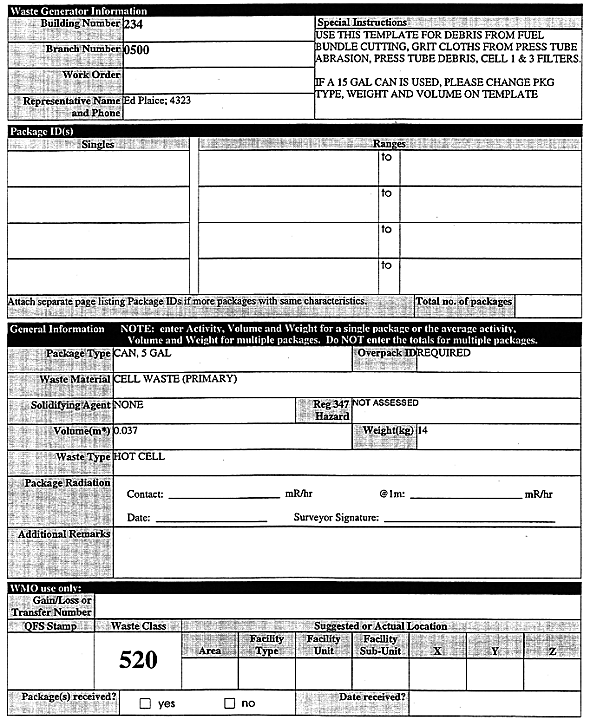
Fig. 4A. Example of the front page
of a template waste data sheet.
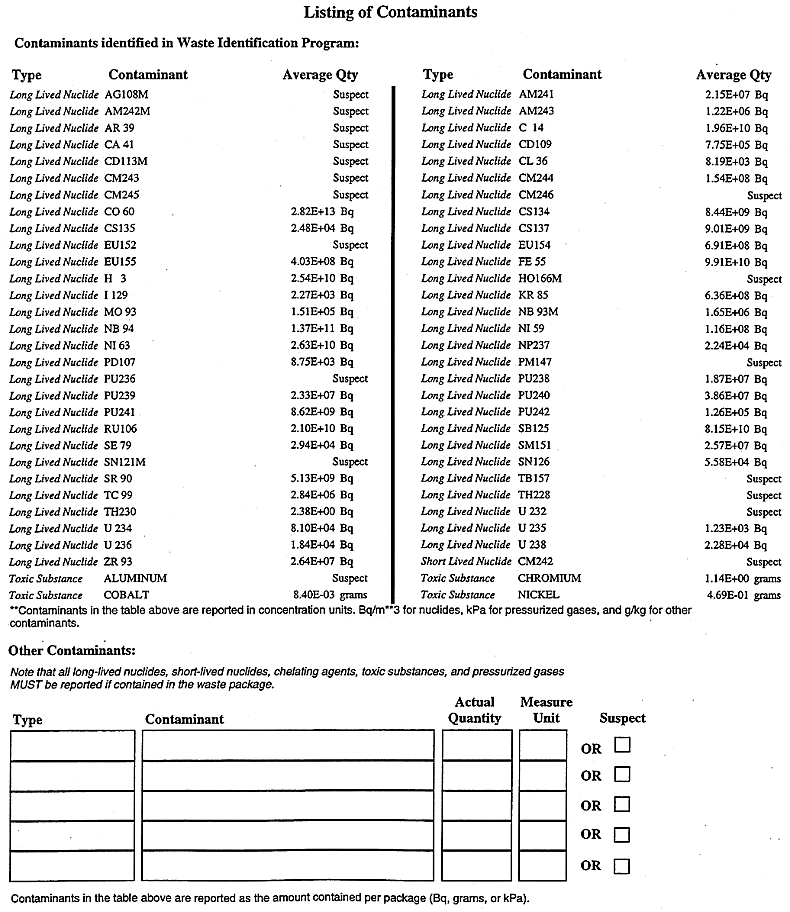
Fig. 4B. Example of the back page of
a template waste data sheet.
Screen capture 1 in Fig. 3A also shows the link to the AECL financial system (Work Order), the typical radiation levels for this waste block (this information is not required and is not passed to the template data sheets), and the average density and estimated annual arisings (EAA) for this waste block (this information is also not required as is also not passed to the template data sheets). The EAA can be used by Performance Assessment staff, in conjunction with estimates of additional waste arisings (such as accumulated inventories and forecasted future 'pulses' that are entered via the Est Volumes button) to forecast inventories of wastes, including a comprehensive contaminants inventory, for any selected time period.
The Hazard field in screen capture 1 of Fig. 3A is used to select one of the Ontario Government's hazardous waste classifications, such as "Acute Hazardous Chemical Waste", if this is applicable to a given waste block.
Screen capture 4 in Fig. 3B shows the list of contaminants identified for a waste block. Radionuclides are recorded as Bq/m3 or g/m3 and toxic/hazardous materials are recorded as g/kg. Contaminant details, such as quantity, category (fissile/non-fissile) and half life are entered using additional WIP-III screens.
When a data sheet is created from a template, package volume and density are used to calculate the inventories of contaminants in each package (Bq or g).
Generators maintain a supply of printed template data sheets for their routine wastes. When they intend to ship wastes, they enter the waste package ID number(s), an overpack ID (if applicable) and radiation field information onto the templates, then submit them for approval by WMDO. If no changes are made to pre-populated fields, approval is essentially automatic. If changes have been made to pre-populated fields, the WMDO Customer Service Representative (CS Rep) follows up to determine why changes have been made. Changes may reflect 'one-off' changes to the waste or they may signal the need to revise WI Program information within WIP-III and to generate a new template.
The use of template data sheets greatly reduces i) the time needed by and ii) the training needed for generators to properly complete documentation that meets WMDO requirements. Since the WI Program maps waste collection points to specific, routine waste blocks and since template data sheets are essentially pre-filled for routine blocks, training amounts to instructing generators on how to match template data sheets to waste blocks for specific collection points. The posting of signs and the labelling of collection points with waste block numbers helps ensure the proper collection, segregation and documentation of wastes.
The use of templates has also greatly reduced the time needed by WMDO to qualify wastes for shipment (QFS) for the following reasons:
WIP-III includes "auto categorization" routines that also greatly reduce the time to QFS wastes. In order to assign a disposal category, WMDO staff have to compare the levels of contaminants reported for waste packages (on data sheets) with administrative limits for contaminants for various disposal facilities. Since Performance Assessments predicted that contaminants would have their maximum effect at different times after a disposal facility is closed, contaminants were placed into various groups and WMDO staff have to calculate the fraction of disposal limits for each contaminant in a package and then perform sums of fractions for each group of contaminants and repeat this for various disposal options. This tedious and time consuming task was replaced by auto categorization routines in WIP-III, which use lookup tables that have administrative limits for contaminants for various the disposal options being considered.
At the time of writing of this paper, the Landlord Geographical Information System (LGIS) at CRL was in the process of assisting WMDO with the marking of waste collection points, signs and barriers to the improper mixing of waste blocks on building maps within the GIS application MapInfo. Since MapInfo is also linked to the CRL Human Resources Information System and the CRL Space Inventory Management System, MapInfo can be used to determine if and when a CRL building or facility that generates wastes changes resource centres or its function changes. As such, MapInfo can be used to trigger a follow up investigation to determine whether or not the information collected by the WI Program and entered into WIP-III needs to be revisited (if the generator changes, the waste changes).
Tracing Information, Qualifying Waste Characterization and Assessing Costs
Screen captures 2 in Fig. 3A and 3 in Fig. 3B show additional WI information that does not appear on template data sheets. These screens are used to:
The link to source documentation provides the "paper trail" that justifies the assignment of an acceptable characterization status.
Once a data sheet has been saved in WIP-III, subsequent changes force an "authorized change" screen, which is used to save the following information:
The concept of "authorized changes" was introduced to:
Currently, radioactive waste disposal facilities have not been established at CRL. At present, only waste storage facilities, that have been operated since the 1940's, are in operation. In addition, until recently the wastes that were accepted for storage were characterized only according to short-term health risk, such as external radiation fields. Currently, some of the waste generated by CRL and accepted for storage may require additional characterization for disposal. As such, WIP-III is used to record information about wastes that are either acceptably or unacceptably characterized for disposal.
The characterization status field in screen capture 2 of Fig. 3A is used to identify which wastes are considered to be acceptably characterized. The status options of "acceptable" or "unacceptable" are within the context of Step 5 of the WI program (see Table III). An "unacceptable" status that is assigned to a waste block indicates that additional characterization is needed to categorize the waste for storage and disposal, within the context of current waste management operations.
To estimate possible future costs for characterizing wastes, a Knowledge Matrix was established (see Table IV). Once estimates of the costs and the effort to characterize wastes are assigned to matrix categories A1 through C3, the costs to characterize wastes can estimated using the Knowledge Matrix categories that were assigned to the various waste blocks (see screen capture 2 in Fig. 3A).
Table IV Knowledge Matrix Used to Estimate Waste Characterization
Costs
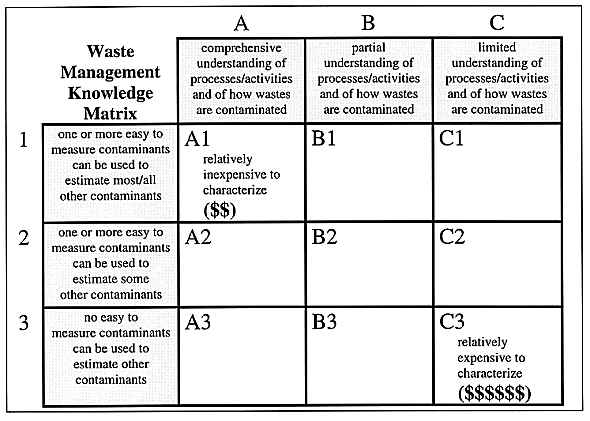
Integrating Compliance Monitoring with Waste Acceptance
WMDO, in conjunction with the major provider of waste characterization and compliance monitoring services at CRL, developed a standard data structure for all characterization and compliance monitoring work. As such, uniform characterization/compliance monitoring records are created from diverse characterization/compliance monitoring methods such as gamma-ray spectrometry, alpha spectrometry, liquid scintillation counting, neutron activation analysis, and inductively coupled plasma mass spectrometry.
Compliance monitoring records are entered into WIP-III lookup tables, where they are compared with waste data sheet information to determine whether or not non-conformances have occurred (see below).
Minimizing Administrative Costs
The following features were integrated within WIP-III to minimize administrative costs associated with waste management activities (the development, implementation and maintenance of a separate set of administrative operating procedures was avoided):
Improving Usability and Security
Even though the data in WIP-III reside in an Oracle database (see the Development Process section) on one of the CRL central computers, WIP-III was developed with a Microsoft Windows front-end rather than an Oracle Screens front-end to improve its user-friendliness and to adhere to the look-and-feel of commonly used Windows software in use at CRL. Users find WIP-III easy to use and robust.
The Oracle application's use of roles is used to restrict access to data to only those allowed to access these data. In addition, Oracle's security features and location of the database on a central computer with regular backup of data provides the data security required by WMDO.
WIP-III DEVELOPMENT PROCESS
Before development of the WIP-III application began, an in-depth feasibility study was done to assess the WIP-II system, to define new system requirements, and to evaluate possible implementation alternatives. ORACLE, AECL's enterprise relational database management system (RDBMS), was chosen as the server database to allow seamless integration with company-wide information systems. It also provides good role-based security and data integrity is ensured by the use of constraints, triggers, and stored procedures. The development tool for the personal computer based, client interface, PowerBuilder, was selected because it allows powerful and flexible development techniques in an object-oriented product.
The application was developed in phases using a similar methodology for each phase. The phase objectives (and high-level system specifications) were defined by way of discussions between the customer (WMDO) and the development team and through rapid prototyping. After review and approval, detailed design and coding to the specifications were done in a team environment with frequent code reviews and walkthroughs. Test cases were defined and documented. An automated testing tool, SQATeamTest, was found to be invaluable in performing the tedious chore of repetitive keystroke entry and verifying expected results. End-user training plans were developed and executed for each phase. The last and important step for each phase was an evaluation to verify that the end-product for the phase reconciled to the objectives defined at the beginning of the phase. The phase evaluation also documented lessons learned during development.
CONCLUSIONS
The WIP-III information system at AECL's Chalk River Laboratories demonstrates that a close working relationship between data managers and waste managers can result in the development of a "database" that exceeds the bounds of merely recording/reporting "waste manifest" information. By working with Waste Management and Decommissioning Operations at the Chalk River Laboratories, the WIP-III development team has provided a product that seamlessly integrates with waste operations to expand data collection and management capabilities with an actual reduction in the cost and efforts associated with these activities.